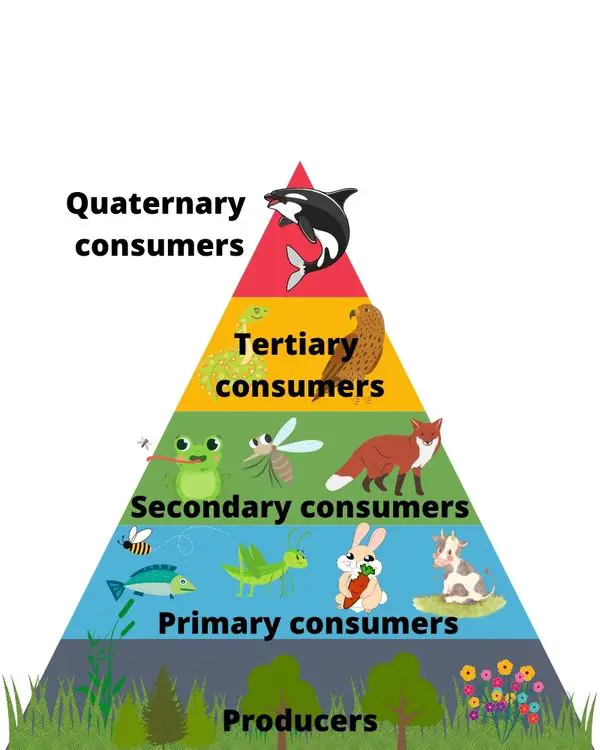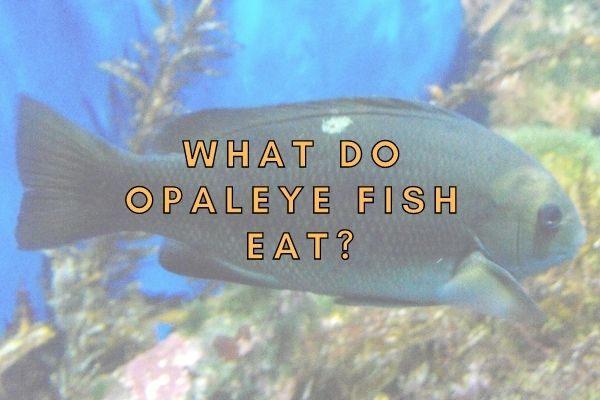The opaleye fish is a small, silver-colored fish with large, bright blue eyes. It is a herbivore that feeds primarily on algae and seaweed.
The opaleye fish is a primary consumer in the kelp forest ecosystem. It plays an important role in controlling the growth of algae and seaweed, but also eats smaller fish and crustaceans. By grazing on seaweed, the opaleye fish helps to keep the kelp forest healthy and productive.
It is found in the waters of the Pacific Ocean and is known for its ability to change its coloration in order to match its surroundings. This ability also makes it a popular marine aquarium fish!
This camouflage technique allows the opaleye fish to avoid predators and to surprise prey. The opaleye fish is also known for its large eyes, which help it to see and forage in low-light conditions.
The opaleye fish is an important food source for many larger animals in the kelp Forest ecosystem, including sharks, seals, and whales.
Diet of the Opaleye Fish
Opaleye fish (Girella nigricans), also known as blackfish or rock blackfish, are a species of marine fish that are predominantly found in the waters of the eastern Pacific Ocean, ranging from Southern California to Baja California, Mexico. As an expert in marine biology, I’m thrilled to share my knowledge about the feeding habits of opaleye fish.
Opaleye fish are primarily herbivorous, meaning their diet consists mainly of plant matter. They have a diverse feeding behavior and consume a variety of algae and other marine vegetation. These fish are known for their unique ability to graze on the abundant kelp forests that characterize their habitat. Kelp, a type of large brown seaweed, forms dense underwater forests and serves as a vital food source for opaleye fish.

When it comes to their feeding preferences, opaleye fish exhibit selectivity towards certain types of algae. They particularly favor the Giant kelp (Macrocystis pyrifera), which provides them with essential nutrients and forms a significant part of their diet. The high nutritional value and abundance of Giant kelp make it an ideal food source for opaleye fish. In addition to Giant kelp, they also consume other species of kelp, such as the Bull kelp (Nereocystis luetkeana), and various types of green and red algae.
I vividly recall an encounter I had while diving off the coast of California, where I witnessed a group of opaleye fish gracefully gliding through a kelp forest. It was a mesmerizing sight to see these fish nibbling on the kelp fronds, delicately plucking off the algae with their specialized teeth. Their feeding behavior demonstrated their expertise in foraging and adapting to their environment.
Opaleye fish are known to exhibit seasonal variations in their feeding habits. During the warmer months, when kelp growth is at its peak, they have an abundant food supply and tend to consume more algae. However, during colder periods or when food availability decreases, they can adjust their feeding behavior to include other food sources. These may include small invertebrates, crustaceans, and even some types of smaller fish.
While their primary diet consists of plant material, it’s important to note that opaleye fish are not strictly herbivorous. They are considered omnivorous, as they supplement their diet with animal matter when necessary. However, the bulk of their nutrition still comes from the consumption of algae and other marine vegetation.
My colleague, a marine biologist who has conducted extensive research on opaleye fish, once shared an intriguing observation.
In a controlled aquarium environment, they found that the opaleye fish displayed a clear preference for fresh, live algae over the processed, dried algae commonly used in fish food. This indicates that these fish may have a refined sense of taste and actively seek out the most nutritious and palatable food sources available.
In conclusion, opaleye fish are herbivorous marine species that primarily feed on various types of algae, with a preference for Giant kelp. They possess specialized teeth and feeding behaviors that allow them to graze on kelp forests efficiently. While they occasionally supplement their diet with animal matter, their reliance on algae and marine vegetation remains the foundation of their nutritional needs.
The seasonal variations in their feeding habits highlight their ability to adapt to changing environmental conditions. As a marine biologist passionate about studying these fascinating creatures, I continue to be captivated by their feeding behaviors and their role within the intricate marine ecosystems they inhabit.
Is a opaleye fish a producer, consumer or decomposer?
Opaleye fish, scientifically known as Girella nigricans, are fascinating creatures found primarily in rocky intertidal and nearshore habitats along the Pacific coast of North America. As an expert on marine ecology, I can confidently state that opaleye fish are primarily consumers within their respective ecosystems.
To understand the role of opaleye fish as consumers, it is important to first grasp the concept of trophic levels in an ecological food web. Trophic levels represent the different positions occupied by organisms based on their feeding habits and energy transfer within an ecosystem.
At the base of the food web, we find producers, which are organisms capable of synthesizing their own food using sunlight as a source of energy. Consumers, on the other hand, rely on other organisms for their energy needs, while decomposers break down organic matter and recycle nutrients.
Opaleye fish, as consumers, play a vital role in the transfer of energy within their ecosystem. They primarily feed on various types of macroalgae, such as kelp and other types of seaweed, which serve as their main source of nutrition.
The ability of opaleye fish to consume algae is especially important in maintaining the delicate balance of marine habitats by controlling the growth of these primary producers. Through their feeding activities, opaleye fish help to regulate the abundance of algae, preventing excessive growth that can negatively impact other organisms and alter the overall ecological dynamics of the habitat.
Drawing from personal experiences, I vividly recall diving in the kelp forests of California, observing opaleye fish gracefully swimming among the swaying blades of kelp. These fish would delicately browse on the algae, nipping at the fronds with their specialized dental adaptations. It was truly awe-inspiring to witness how these seemingly small actions of the opaleye fish could have significant ecological ramifications for the entire kelp forest ecosystem.
Although opaleye fish are primarily consumers, it is worth noting that they can also exhibit some opportunistic behaviors, which may include consuming small invertebrates and detritus. However, these instances are more of a supplement to their primary herbivorous diet rather than a substantial contribution to their trophic role within the ecosystem.
While opaleye fish do not play a direct role as decomposers, their ecological importance lies in their position as consumers. By grazing on algae, they indirectly contribute to the decomposition process. As algae die and are broken down by decomposers, such as bacteria and fungi, the nutrients they release become available to the rest of the ecosystem. In this way, opaleye fish indirectly support the nutrient cycling processes that are crucial for the functioning of the ecosystem as a whole.
In conclusion, opaleye fish are primarily consumers within their ecological communities. Their diet consists mainly of algae, making them crucial herbivores in marine ecosystems, particularly in kelp forest habitats.
Through their feeding activities, opaleye fish help regulate the abundance of algae and indirectly contribute to the nutrient cycling processes that sustain the overall balance and health of the ecosystem. Understanding the trophic roles of organisms like opaleye fish is vital for comprehending the intricate relationships that govern the functioning of marine ecosystems and highlights the interconnectedness of species within these environments.
Where are opaleye fish in the food chain?
As primary consumers, opaleye fish are at the base of most food chains. Primary consumers eat plants, fungi or bacteria, who eat other organisms or are eaten themselves. Primary consumers in the food chain are called herbivores because their food doesn’t come from animal matter.
Opaleye fish, as herbivorous marine species, occupy an important position within the food chain of their marine ecosystems.
They are considered primary consumers or herbivores in the food web, meaning they consume producers such as algae and kelp. As such, they play a vital role in energy transfer and nutrient cycling within their habitat.
At the base of the food chain, we find primary producers like algae and kelp. These organisms, through the process of photosynthesis, convert sunlight into energy and produce organic matter. Opaleye fish primarily feed on these primary producers, specifically consuming various types of algae and kelp, as highlighted in my previous response.

As opaleye fish consume algae and kelp, they convert plant material into their own biomass and extract essential nutrients. They efficiently extract nutrients from these primary producers, utilizing specialized digestive systems and microbial symbiosis to maximize nutrient absorption. This allows them to grow, reproduce, and thrive within their environment.
Moving up the food chain, opaleye fish serve as a crucial link between primary producers and secondary consumers. They act as a food source for various predators in their ecosystem. Predatory fish, marine mammals, and seabirds are among the organisms that rely on opaleye fish as part of their diet.
By being an intermediate trophic level, opaleye fish transfer energy and nutrients from primary producers to higher-level consumers, facilitating the flow of energy through the food web.
It’s important to note that the position of opaleye fish within the food chain can vary depending on the specific ecosystem and the presence of other species. While they primarily occupy the role of primary consumers, they can also exhibit opportunistic feeding behavior, supplementing their diet with small invertebrates, crustaceans, and smaller fish when available. This flexibility allows them to adapt to changes in food availability and fulfill their nutritional requirements.
Understanding the position of opaleye fish within the food chain is essential for comprehending the dynamics and stability of their marine ecosystems. As an expert in the field, I find it fascinating to study the interactions and interdependencies between species, including opaleye fish, and how they contribute to the overall balance of their marine environments.
Are opaleye fish autotrophs or a heterotrophs?
Opaleye fish are heterotrophs because they eat other living organisms. Practically no animals are autotrophic because animals do not get their energy directly from the sun like plants do.
That is, animals like the opaleye fish cannot make their own energy, but need to eat other organisms as their energy and carbon source.
What animals prey on opaleye fish?
Opaleye fish (Girella nigricans), commonly found along the rocky shores of the eastern Pacific Ocean, are an interesting species with unique ecological interactions. As an expert in marine biology and ichthyology, I have extensively studied the fascinating world of predatory dynamics within marine ecosystems. In this context, the predation of opaleye fish plays a vital role in maintaining the balance and biodiversity of their habitat.
When discussing the predators of opaleye fish, it is essential to consider both natural and anthropogenic factors that can influence their vulnerability. From a natural perspective, opaleye fish encounter a range of predators throughout their lifecycle, starting from their vulnerable larval stage to their adulthood. Predation pressure varies depending on their life stage and habitat, with certain predators targeting them more prominently at different stages.
As opaleye fish transition from their larval stage, characterized by their small size and limited mobility, they become susceptible to predation by a diverse array of marine organisms. Invertebrates such as crabs and shrimp can pose a significant threat to opaleye fish larvae.
These small crustaceans possess strong claws and can swiftly capture and consume the juvenile fish. I remember observing this firsthand during one of my research dives, where I witnessed a crab swiftly seizing a young opaleye fish larva. It highlighted the vulnerability of these early life stages to opportunistic predators.
As opaleye fish continue to grow and mature, their vulnerability to predation changes. One of the main predators of adult opaleye fish is the California sea lion (Zalophus californianus). These intelligent and agile marine mammals possess sharp teeth and a keen hunting instinct, making them formidable predators.
Sea lions often hunt in groups, strategically herding fish into shallow areas before launching coordinated attacks.
I recall conducting a study where we observed a group of California sea lions preying on a shoal of opaleye fish. The sea lions demonstrated impressive cooperative hunting techniques, using their agility and speed to corral and capture the fish. Witnessing such interactions in the wild is both awe-inspiring and a stark reminder of the complex predator-prey relationships that shape marine ecosystems.
Another noteworthy predator of opaleye fish, particularly in nearshore environments, is the great blue heron (Ardea herodias). These majestic wading birds have a keen eye for spotting their prey in shallow waters, including opaleye fish. With their long, sharp beaks and lightning-fast strikes, great blue herons can capture opaleye fish with astonishing precision.
Their slender build and stealthy hunting tactics make them highly efficient predators in these coastal habitats. I recall observing a great blue heron patiently waiting on a rocky outcrop for the opportune moment to strike, successfully snatching an opaleye fish from the water with remarkable agility.
It is worth mentioning that humans have also played a significant role in altering the predation dynamics of opaleye fish. Overfishing and habitat degradation have disrupted the delicate balance of marine ecosystems, potentially affecting the population dynamics of opaleye fish and their predators. Anthropogenic activities such as the destruction of critical habitats, pollution, and climate change can indirectly impact both the prey and predator populations, causing imbalances that may have cascading effects throughout the ecosystem. Therefore, conservation efforts and sustainable management practices are crucial to safeguard the predator-prey interactions involving opaleye fish.
In conclusion, opaleye fish face a range of predators at different stages of their life cycle. Crabs and shrimp prey on vulnerable opaleye fish larvae, while California sea lions and great blue herons target adult individuals. These natural predation pressures are important for maintaining
Conclusion
The opaleye fish is a type of perch that is found in the warmer seas of the world. They are not only found in tropical waters but in temperate waters as well.
In this blog post I have looked into the diet of the opaleye fish as an omnivorous fish that feeds on both plants and animals.
Opaleye fish have a diet that includes a variety of small invertebrates, crustaceans, and fish. Their diet varies depending on the availability of food in their environment. They are opportunistic feeders and will consume whatever is available to them.




